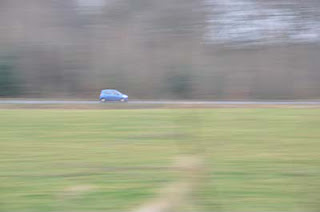This image of a wooden reel has been abstracted by excluding all surrounding detail from the picture. The composition becomes graphic and the eye is attracted to the motion of the vertical lines leading it through the textures of the wood.
This image is a repeating pattern of verticals but also forming an implied diagonal through the image, there are also other verticals on the boat itself. Taken with a longer focal length, the compression in the image emphasises the verticals and diagonals. In this image, I think the verticals in a diagonal line provide some depth and dimension to the image.
Although this image shows curves and diagonals, I think the vertical is prominent in the image and shows a clear division of the ships bow and the image. The other lines support rather than dominate this image.
This image has both horizontal and vertical elements but the vertical repeating pattern of the tree trunks are the main element. The horizontal division shows a base for supporting the verticals and I think the horizontal lines of the field emphasise this.
Again this image has both horizontal and vertical elements but it is the horizontal rung of the ladder and it's shadows which define the graphic qualities of this image.
Despite the prominence of the vertical supporting elements in the frame, I think the horizontals are the strongest element of the image. Perhaps because they are abstracted implying a larger area. This is an example where the lines support the main element of the composition which is the textured wood lying on a third.
This image shows the horizontal supporting lines of an old wall. They indicate strength which is contrasted by the lower line crumbling away and no longer being as strong or supportive.
Key Learning Points
Lines provide a graphical element to a composition but seem to have more visual weight when they are abstracted. Completely abstracted they can be powerful graphic compositions but can also support other compositional elements like textures. Horizontals and verticals seem to imply strength, support and structure but in doing so they also make the subject static.
















































